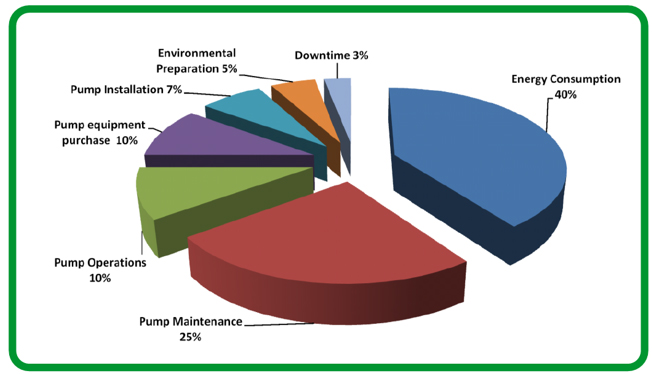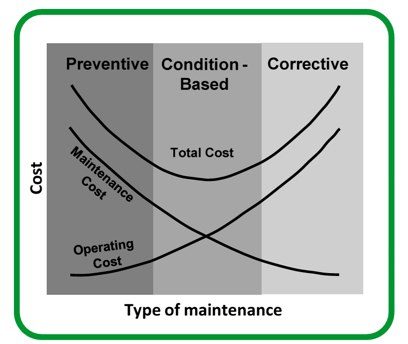This article is part of a three-part series looking at the importance of Smart Pumping and the value of new technologies behind it.
Authors: Hussain Ahmed, Schneider Electric, and Jack Creamer, Schneider Electric
In addition to energy savings, asset management also comes into play, and it can account for upwards of 35% of the Total Cost of Ownership (TCO) of pumps. Operations and maintenance costs are unavoidable due to ongoing system operation. However, numerous steps can be taken to ensure that these costs are kept to a minimum, while enhancing the integrity of the system.
Figure 1: Typical pump life-cycle cost profile – Courtesy of the Hydraulic Institute and Pump Systems Matter
Pumps are designed for optimal operation at the Best Efficiency Point (BEP), but 75% of pump systems are oversized due to factors such as provisional system growth, varying duty cycles, etc. Variable speed drives can help keep the operating point close to the BEP. Protect pumps against destructive forces and provide feedback on pump system operating issues – both locally and remotely.
There are three primary approaches that can be used to monitor and optimize pump operation:
- Preventive maintenance – implies a systematic inspection and detection of potential failures before they occur
- Condition based maintenance – a type of preventative maintenance that estimates and projects equipment condition over time, utilizing formulas to assess downtime risks
- Corrective maintenance – a response to an unanticipated problem or emergency
Figure 2 – Cost curves of the different maintenance approaches – Courtesy of Penn State University/Applied Research Laboratory
Variable speed drives have the capability of measuring process variable to assess pump efficiency. When connected to the broader operating system – locally and/or remotely – they continuously monitor the health of the system and can indicated when proper maintenance is needed.
Global water shortages, the growth in urban population, environmental regulations, and process inefficiencies are all contributing to a crisis in the water / wastewater industry. With the combination of energy consumption and operating / maintenance costs accounting for 75% of pump system TCO, migration to new “smart pumping / intelligent pumping” approaches can help water / wastewater organizations address these challenges.
Conclusion
The transition to smart pumping will be a major step forward in addressing the challenges of global water / wastewater management. Both private and municipally-managed facilities can no longer afford inefficient high cost operations that require high maintenance.
In order to enable this transition the following steps should be considered:
- Introduce energy consumption measurement devices into the water / wastewater architecture. Data from energy meters enable improvements in energy efficiency (you can’t manage what you don’t measure) and also allows operators to perform proactive, low cost maintenance.
- Deploy modern controllers with high intelligence for improved security, reduced commissioning time, and better regulation compliance.
- Replace fixed-speed pumps with variable speed pumps (enabled by variable speed drives).
- Enable “smart” visibly into the network of pumping systems through the deployment of remote monitoring. This reduces both maintenance and energy costs.
READ PART 1 – Smart Pumping: A New Way to Address the Worldwide Water Distribution Crisis
READ PART 2 – Why Pumping Infrastructure Matters!
About the Authors
Hussain Ahmed is Program Manager in Schneider within the Industry Division’s OEM Segment team. Since 1994 he has focused on automation and commissioning projects, as well as global software and architecture development. Mr. Ahmed holds Bachelor’s degree in Electronic Engineering. He joined Schneider Electric in 2006 and has executed several roles including marketing, business development, and software development /commissioning.
Jack Creamer is Schneider Electric Segment Marketing Manager – Pumping Equipment, based in the United States. Mr. Creamer has more that 30 years in the Electrical Industry, and has been involved for 10 years in the Pumping Industry. He is involved in key industry organizations such as the Hydraulic Institute and Submersible Wastewater Pump Association, where he holds both Committee Chair and Board level positions. In his time in the Pump industry, he has help Schneider create numerous solutions that both enhance pumping efficiency and address issues such as maintenance and downtime.






Comments